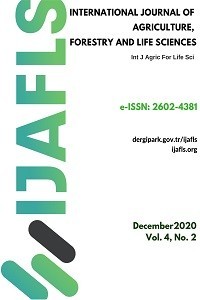Olive Selection Studies in East Mediterranean Region
Olive Selection Studies in East Mediterranean Region
Olea europeae, olive, selection,
___
- Akıllıoglu M, Ozen YA, Akay Z, Ozen H, Aksu B, Dizdaroğlu T, Özahçı E, 2000. Zeytin Raporu. VII. beş yıllık kalkınma planı bitkisel üretim özel ihtisas komisyonu meyvecilik grubu (In Turkish).
- Arsel H, Sefer F, 2006. Bazı Önemli Yerli ve Yabancı Zeytin Çeşitlerinin Bölgelerimize Adaptasyonu. Ulusal Zeytin ve Zeytinyağı Sempozyum ve Sergisi. 539-549 (In Turkish).
- Baccourı B, Guerfel M, Zarrouk W, Taamallı W, Daoud D, Zarrouk M, 2009. Wild Olive (Olea europaea L.) Selection For Quality Oil Production. Journal of Food Biochemistry 35:161–176
- Bolat İ, Guleryuz M, 1995. Çoruh Vadisinde Yetiştirilen Zeytin Çeşitlerinin Bazı Pomolojik Özelliklerinin İncelenmesi Üzerine Bir Araştırma. Türkiye II. Ulusal Bahçe Bitkileri Kongresi, Adana. l: 736-740 (In Turkish).
- Bostan SZ, 2009. A Research on Preselection of Native Olive Types (Olea Europeae) Grown in Trabzon Province (Eastern Black Sea Region of Turkey). Acta Horticulturae.825:111-116.
- Canozer Ö, 1991. Standart Zeytin Çeşitleri Kataloğu. Tarım ve Köyişleri Bakanlığı, Mesleki Yayınlar, No:334-16. Ankara, 107 s. (In Turkish).
- FAO, 2023. https://www.fao.org/faostat/en/#data/QCL. Date:02.04.2023
- Ferrara E, Lamparelli F, 1995. Results of six years of research on the agronomic and commercial performance of ten olive cultivars in Puglia. Atti Del Convegno L’olivicoltura Mediterranea; Stato E Prospettive Della Coltura A Della Ricerca. Rende (CS). Gennaio, 29-31. (In spanish)
- Ganino, T. and Fabbri, A. (2005). Genetic characterization of Olea europaea L. germplasm in northern Italy. Vth International Symposium on Olive Growing, Izmir, Turkey. 127.
- Gezerel Ö, (1980). Zeytinlerde boğma ve bilezik alma uygulamalarının verim, kalite ve yapraklardaki bitki besin maddeleriyle karbonhidrat düzeylerine etkisi. Doçentlik Tezi, Adana, 115s. (In Turkish).
- Gundogdu MA, Kaleci N, Nergis O, Doğan E, 2016. Farklı Zaman Periyotlarında Hasat Edilen Bazı Yabancı Kökenli Zeytin Çeşitlerinin Pomolojik ve Bazı Biyokimyasal Karakterlerindeki Değişimlerin Saptanması. Zeytin Bilimi, 6 (2) , 61-67. (In Turkish).
- IOOC, 2007. Optimal Harvest Time. In: Tombesi A. and Tombesi S., Eds. Production Techniques in Olive Growing. Kaynaş N, Sütçü AR, Fidan AE, 1996. Zeytinde Adaptasyon (Marmara Bölgesi). Atatürk Bahçe Kültürleri Araştırma Enstitüsü, Bilimsel Araştırma ve İncelemeler Yayın no:82, 27s., Yalova. (In Turkish).
- Lavee S, 1990. Aims, Methods and Advances in Breeding of New Olive (Olea europaea L.) cultivars. Acta Hortic, 286: 23-26
- Lavee S, 1998. Zeytinin Biyolojisi ve Fizyolojisi. Dünya Zeytin Ansiklopedisi Uluslararası Zeytinyağı Konseyi, İspanya, s 61 – 110. (In Turkish).
- Mizgin A. 2018. Derik İlçesinde Yetiştirilen Yerel Zeytin Çeşitlerinin Bazı Morfolojik, Fenolojik, Pomolojik ve Kimyasal Özelliklerinin Belirlenmesi. Harran Üniversitesi Fen Bilimleri Enstitüsü. Yüksek Lisans Tezi. S:23-27. (In Turkish).
- Özelbaykal S, 1995. Çukurova Bölgesinde Yetiştiriciliği Yapılan Zeytinlerde Azotlu Gübresinin Verim Kalite ve Bitki Besin Maddeleri İçerikleri Üzerine Etkileri. Çukurova Üniversitesi Fen Bilimleri Enstitüsü, Bahçe Bitkileri Ana Bilim Dalı, Doktora Tezi. S: 76-83. (In Turkish).
- Pannelli G, Volpe D, Preziosi P, Famiani F, 1994. Comparison of the Vegetative and Reproductive Charactersitics of Traditional Olive Cultivars and Selected Low Vigorous Accessions in Central Italy. Acta Horticulturae. 356:123-126
- Şeker M, Gündoğdu MA, Gül MK, Kaleci N, 2012. Doğu Karadeniz Bölgesi Bazı Yerli Zeytin Çeşitlerinin Pomolojik Özellikleri. Zeytin Bilimi, 3 (2), 91-97. Retrieved from https://dergipark. org.tr/en/pub/zeytin/issue/28966/309897. (In Turkish).
- Solinas M, 1990. Olive Oil Quality and Its Determining Factors. Problems on Olive Oil Quality Congress, Florence-Italy. 381-383 p.
- Susamcı, E., Otles, S., Irmak, S. 2011. Sofralık zeytinin besin öğeleri, duyusal karakterizasyonu ve işleme yöntemleri arasındaki etkileşimler. Zeytin Bilimi, 2(2), 65-74. (In Turkish).
- Toplu C, 2000. Hatay ili Değişik Üretim Merkezlerindeki Zeytinliklerin Verimlilik Durumları, Fenolojik, Morfolojik ve Pomolojik Özellikleri ile Beslenme Durumları Üzerinde Araştırmalar. Doktora Tezi. Çukurova Üniversitesi, Adana. (In Turkish).
- Ugur R, Paydas Kargı S, 2017. Investigation of growing situations of apricot varieties grafted on clonal rootstock candidate some wild plum genotypes obtained by selection. Turkish Journal of Natural and Agricultural Science, 5: 64-70.
- Ulas M, 2001. Çukurova bölgesinde yaygın bazı sofralık ve yağlık zeytin çeşitlerinin morfolojik, fenolojik ve pomolojik özelliklerinin belirlenmesi. Çukurova Üniversitesi. Fen Bilimleri Enstitüsü, Bahçe Bitkileri Ana Bilim Dalı, Yüksek Lisans Tezi, 106. (In Turkish).
- Yayın Aralığı: Yılda 2 Sayı
- Başlangıç: 2017
- Yayıncı: Volkan OKATAN
Perception of Food Safety in Fish Consumption: The Case of Antalya Province
Serpil YILMAZ, Celile DÖLEKOĞLU, İbrahim YILMAZ, Erkan GÜMÜŞ, Ali AKAY, Evrim Beyhan ŞEN ŞENSOY
Ömer Faruk BİLGİN, Şule Hilal ATTAR, Ebru KAFKAS, Salih KAFKAS
Olive Selection Studies in East Mediterranean Region
Remzi UĞUR, Özkan ALTUN, Muhammet Ali GÜNDEŞLİ
Distribution of Polygonaceae family in Türkiye
